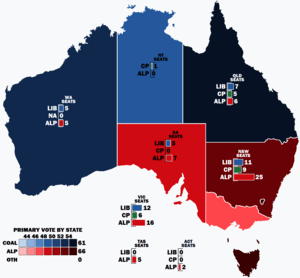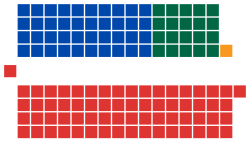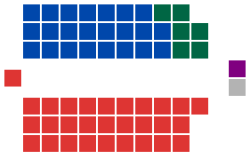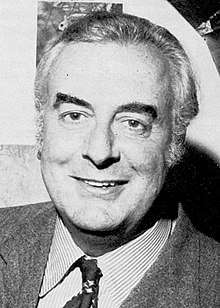1974 Australian federal election
The 1974 Australian federal election was held in Australia on 18 May 1974. All 127 seats in the House of Representatives and all 60 seats in the Senate were up for election, due to a double dissolution. The incumbent Labor Party led by Prime Minister Gough Whitlam defeated the opposition Liberal–Country coalition led by Billy Snedden.
| |||||||||||||||||||||||||||||||
All 127 seats of the House of Representatives 64 seats were needed for a majority in the House All 60 seats of the Senate | |||||||||||||||||||||||||||||||
|---|---|---|---|---|---|---|---|---|---|---|---|---|---|---|---|---|---|---|---|---|---|---|---|---|---|---|---|---|---|---|---|
| |||||||||||||||||||||||||||||||
 Popular vote by state and territory with graphs indicating the number of seats won. As this is an IRV election, seat totals are not determined by popular vote by state or territory but instead via results in each electorate. | |||||||||||||||||||||||||||||||
| |||||||||||||||||||||||||||||||
Prior to the election the voting age had been reduced from 21 to 18 years. The election was held in conjunction with four referendum questions, none of which were carried.
Future Prime Minister John Howard entered parliament at this election. Snedden became the first Liberal Leader not to serve as prime minister.
Background and issues
Gough Whitlam had been an active prime minister since his party's victory in the 1972 election, and his government had pursued many socially progressive reforms and policies over its first term. However, it suffered through the 1973 oil crisis and the 1973–75 recession and received a hostile reception from the coalition/DLP-controlled Senate, with the last Senate election held in 1970.
Following an attempt by Whitlam to create an extra Senate vacancy in Queensland by appointing former Democratic Labor Party (DLP) Leader, Senator Vince Gair, as Ambassador to the Republic of Ireland, Snedden announced that the opposition would block the Government's supply bills in the Senate. After a great deal of legalistic argumentation in both houses about the Gair Affair, and justified by the failure of six (non-supply) bills to pass the Senate, Whitlam requested and was granted by Governor-General Sir Paul Hasluck a double dissolution under section 57 of the Constitution. The already-announced election date of 18 May was kept. The election focused on Whitlam's first one-and-a-half years in office and whether the Australian public was willing to continue with his reform agenda.
Results
House of Representatives results

| Party | Votes | % | Swing | Seats | Change | ||
|---|---|---|---|---|---|---|---|
| Labor | 3,644,110 | 49.30 | −0.29 | 66 | −1 | ||
| Liberal–Country coalition | 3,379,545 | 45.73 | +4.25 | 61 | +3 | ||
| Liberal | 2,582,968 | 34.95 | +2.91 | 40 | +2 | ||
| Country | 736,252 | 9.96 | +0.52 | 21 | +1 | ||
| National Alliance | 60,325 | 0.82 | +0.82 | 0 | -2 | ||
| Australia | 172,176 | 2.33 | −0.09 | 0 | 0 | ||
| Democratic Labor | 104,974 | 1.42 | −3.83 | 0 | 0 | ||
| Liberal Movement | 57,817 | 0.78 | +0.78 | 0 | 0 | ||
| Socialist | 1,132 | 0.02 | +0.00 | 0 | 0 | ||
| Republican | 934 | 0.01 | +0.01 | 0 | 0 | ||
| Communist | 539 | 0.01 | –0.11 | 0 | 0 | ||
| Independents | 29,779 | 0.40 | –0.56 | 0 | 0 | ||
| Total | 7,391,006 | 127 | +2 | ||||
| Two-party-preferred (estimated) | |||||||
| Labor | WIN | 51.70 | −1.00 | 66 | −1 | ||
| Liberal–Country coalition | 48.30 | +1.00 | 61 | +3 | |||
- Notes
- The National Alliance was an electoral alliance of the Country Party and the Democratic Labor Party in Western Australia. It defended two seats that had elected the Country Party in 1972 but lost them both.
Senate results

Labor (29)
Opposition (29)
Coalition
Liberal (23)
Country (6)
Crossbench (2)
Liberal Movement (1)
Independent (1)
| Party | Votes | % | Swing | Seats Won | Seats Held | Change | ||
|---|---|---|---|---|---|---|---|---|
| Labor | 3,127,197 | 47.29 | +5.08 | 29 | 29 | +3 | ||
| Liberal–Country coalition | 2,901,454 | 43.88 | +5.70 | 29 | 29 | +3 | ||
| Liberal–Country joint ticket | 2,298,816 | 34.77 | +15.26 | 16 | * | * | ||
| Liberal | 516,919 | 7.82 | −9.79 | 12 | 23 | +2 | ||
| National Alliance | 55,301 | 0.84 | +0.84 | 1 | * | * | ||
| Country | 30,418 | 0.46 | –0.60 | 0 | 6 | +1 | ||
| Democratic Labor | 235,343 | 3.56 | −7.55 | 0 | 0 | –5 | ||
| Australia | 92,107 | 1.39 | −1.51 | 0 | 0 | 0 | ||
| Liberal Movement | 63,032 | 0.95 | +0.95 | 1 | 1 | +1 | ||
| National Liberal | 23,965 | 0.36 | +0.36 | 0 | 0 | 0 | ||
| Communist | 20,583 | 0.31 | +0.31 | 0 | 0 | 0 | ||
| United Christian | 3,977 | 0.06 | +0.06 | 0 | 0 | 0 | ||
| United Tasmania | 2,051 | 0.03 | +0.03 | 0 | 0 | 0 | ||
| National Socialist | 1,810 | 0.03 | –0.40 | 0 | 0 | 0 | ||
| Republican | 484 | 0.01 | +0.01 | 0 | 0 | 0 | ||
| Social Credit | 379 | 0.01 | +0.01 | 0 | 0 | 0 | ||
| Independents | 140,003 | 2.12 | +0.41 | 1 | 1 | –2 | ||
| Total | 6,612,385 | 60 | 60 | |||||
- Notes
- The Country Party (CP) contested the elections in Western Australia as the National Alliance (NA), which was a merger of the CP and the Democratic Labor Party (DLP) in that state. The NA won a single Senate seat in WA, its elected representative being Tom Drake-Brockman, who sat with the CP on election to parliament.
- Independent: Michael Townley (Liberal Party from Feb 1975)
Seats changing hands
| Seat | Pre-1974 | Swing | Post-1974 | ||||||
|---|---|---|---|---|---|---|---|---|---|
| Party | Member | Margin | Margin | Member | Party | ||||
| Canning, WA | National Alliance | John Hallett | N/A | 26.1 | 14.3 | Mel Bungey | Liberal | ||
| Henty, Vic | Liberal | Max Fox | 0.3 | 1.8 | 1.5 | Joan Child | Labor | ||
| Hume, NSW | Labor | Frank Olley | 1.9 | 2.6 | 0.7 | Stephen Lusher | Country | ||
| Isaacs, Vic | Liberal | David Hamer | 1.1 | 1.7 | 0.6 | Gareth Clayton | Labor | ||
| Lilley, Qld | Labor | Frank Doyle | 0.0 | 1.0 | 1.0 | Kevin Cairns | Liberal | ||
| Mitchell, NSW | Labor | Alfred Ashley-Brown | 1.2 | 2.7 | 1.5 | Alan Cadman | Liberal | ||
| Moore, WA | National Alliance | Don Maisey | N/A | 1.4 | 10.5 | John Hyde | Liberal | ||
| Riverina, NSW | Labor | Al Grassby | 6.9 | 7.7 | 0.8 | John Sullivan | Country | ||
| Wide Bay, Qld | Labor | Brendan Hansen | 3.3 | 6.8 | 3.5 | Clarrie Millar | Country | ||
Aftermath
Election result
The Whitlam Government had been re-elected with their majority in the House of Representatives reduced from 9 to 5 seats, while they gained 5 seats in the Senate. The ALP and the coalition each won 29 seats in the 60 member Senate, with the balance of power held by Steele Hall of the Liberal Movement, and Michael Townley, a conservative independent. The Democratic Labor Party, which had been rendered obselete by the election of the Whitlam government in 1972, lost all five of its Senate seats.[1]
Al Grassby who served as Minister for Immigration in the Labor Whitlam Government lost his seat. Grassby's actions as immigration minister attracted criticism from anti-immigration groups, led by the Immigration Control Association, which targeted his electorate in a campaign at the May 1974 election. Partly as a result, Grassby was defeated by the National Party candidate, John Sullivan, by just 792 votes. Grassby and his supporters accused these groups of mounting a smear campaign against him.[2]
Joint sitting
The re-elected Whitlam government's failure again to gain a majority in the Senate led to the 1974 joint sitting, Australia's only joint sitting, pursuant to section 57 of the Constitution. It was approved by the new governor-general Sir John Kerr after the bills were presented to the new parliament and were rejected a third time. It was held three months after the election, on 6–7 August, and it enabled the six bills that had been thrice rejected by the Senate to be passed. The Health Insurance bills were both passed on party lines, 95–92, the Petroleum and Minerals Authority legislation also passed on party lines, though with one Liberal Party member absent. Liberal Movement Senator Steele Hall supported the three Electoral bills, citing his experience as Liberal Premier of South Australia, where he had fought his own party in an effort to improve unequal electoral arrangements dubbed the Playmander. Northern Territory Country Party MP Sam Calder supported the Territory Senators legislation, though he opposed the ACT being given added representation.[3]
Subsequent changes
In February 1975, the independent senator Michael Townley joined the Liberal party. This gave the Coalition 30 out of 60 Senators, with 29 Labor and 1 Liberal Movement (Steele Hall).
Later in 1975, two Coalition premiers would break longstanding convention in the replacement of two ALP senators. Lionel Murphy, who had resigned to take up an appointment to the High Court, was replaced by independent Cleaver Bunton; and Bertie Milliner, who had died, was replaced by Albert Field, an ALP member who was opposed to Whitlam. Bunton (along with Hall) refused to vote against supply, but Field was prepared to. Field took his seat in the Senate as an Independent on 9 September. Due to a High Court challenge to his appointment, he was on leave from the Senate, unable to exercise a vote, from 1 October 1975, which reduced the number of sitting senators to 59. This gave the Coalition an effective majority, holding 30 of the 59, allowing them to block supply in the Senate to pave the way for the 1975 Australian constitutional crisis.
See also
- Candidates of the Australian federal election, 1974
- Members of the Australian House of Representatives, 1974–1975
- Members of the Australian Senate, 1974–1975
References
- Fred Daly, From Curtin to Kerr, 1977, Sun Books, Sydney.
- "Whitlam government minister Al Grassby dies". The Sydney Morning Herald. Fairfax Media. 23 April 2005. Retrieved 6 August 2010.
- "Archived copy". Archived from the original on 29 September 2007. Retrieved 17 October 2007.CS1 maint: archived copy as title (link)
Bibliography
- AustralianPolitics.com 1974 election details
- University of WA election results in Australia since 1890
- AEC 2PP vote


